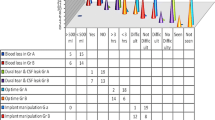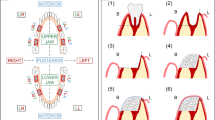Abstract
To gain a better under-standing of the strength and long term viability of split calvarial bone graft, nine mongrel dogs each received four trephine craniotomies (1.5 mm diameter). The harvested bone plugs were split through the diploë and a partial-thickness plug was returned to each craniotomy site. The unused partial-thickness plugs underwent strength testing. After 90–150 days the dogs were sacrificed, bone scans and X-rays of the graft recipient sites performed, and the grafted plugs harvested for strength testing and histologic examination. Bone scanning showed increased osteoblastic activity within the grafts, strength testing showed a progressive loss in strength over the 150 days, and histologic examination demonstrated a creeping substitution. These results imply a similar evolution in strength and remodeling to that seen in long-bone grafts, whose remodeling typically spans 1 year.
Similar content being viewed by others
References
Blair GAS, Gordan DS, Simpson DA (1980) Cranioplasty in children. Child's Brain 6: 82–91
Coleman CC (1920) The repair of cranial defects by autogenous cranial transplants. Surg Gynecol Obstet 31: 40–44
Edwards MSB, Ousterhout DK (1987) Autogenic skull bone grafts to reconstruct large or complex skull defects in children and adolescents. Neurosurgery 20: 273–280
Ennerino WF, Burchalot H, Puhl JJ (1975) Physical and biological aspects of repair in dog cortical-bone transplants. J Bone Joint Surg [Am] 57: 237–252
Jackson IT, Pellet C, Smith JM (1983) The skull as a bone graft donor site. Ann Plast Surg 11: 527–532
Prolo DJ, Rodrigo JJ (1985) Contemporary bone graft physiology and surgery. Clin Orthop Rel Res 200: 322–342
Prolo DJ, Burres KP, McLaughlin WT (1979) Autogenous skull cranioplasty: fresh and preserved (frozen), with consideration of the cellular responses. Neurosurgery 4: 18–29
Raisz LG, Kream BE (1983) Regulation of bone formation. N Engl J Med 309: 29–35, 83–89
Sato K, Vtist MR (1985) Induced regeneration of calvaria by bone morphogenic protein (BMP) in dogs. Clin Orthop Rel Res 197: 301–311
Tessier P (1982) Autogenous bone grafts taken from the calvarium for facial and cranial applications. Clin Plast Surg 9: 531–538
Author information
Authors and Affiliations
Rights and permissions
About this article
Cite this article
Abbott, R., Laurent, J.P., Cheek, W.R. et al. Survival of split calvarial bone grafts in a dog model. Child's Nerv Syst 10, 249–251 (1994). https://doi.org/10.1007/BF00301163
Received:
Issue Date:
DOI: https://doi.org/10.1007/BF00301163




